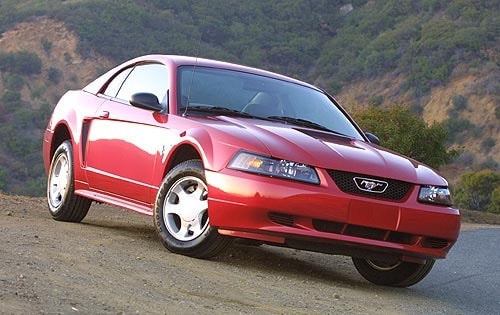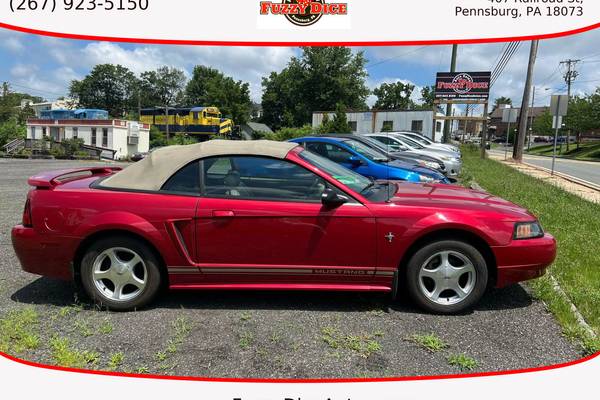2001 Ford Mustang Review
Price: $29,988
 View 39 more photos
View 39 more photos View 39 more photos
View 39 more photos View 39 more photos
View 39 more photos View 39 more photos
View 39 more photos View 39 more photos
View 39 more photos+35
Ford Mustang model years
Ford Mustang types
Edmunds' Expert Review
by the Edmunds Experts
Pros
- Strong V8 power, competent chassis and brakes, good crash test scores, ragtop option.
Cons
- Solid rear axle, dorky-looking fake hood and side scoops, poor stereo ergonomics.
What’s new
2001 Ford Mustang GT models get unique hood and side scoops, so that you can tell 'em apart from V6 models. They also receive standard 17-inch wheels, and V6 Convertibles get 16-inch wheels as standard. All cars have a revised center console and blacked-out headlights and spoilers. The Mach 460 stereo system comes with an in-dash six-disc CD changer. A new "premium" trim line is created for both V6 and V8 models. After a one-year hiatus, the Ford SVT Mustang Cobra returns for 2001.
Edmunds says
The original pony car is still one of the best, and there's a good reason for this sport coupe's longevity.
For sale near Riverside, NJ
67 listings
- 19,570 miles
- No accidents, 3 owners, personal use only
- 8cyl manual
- Auto Addictions Auto Sales (16 mi away)
- Leather Seats
- Alarm
- Fold Flat Rear Seats
Close
Located in Blackwood, NJ
Auto Addictions Sales 1104 N Black Horse Pike Blackwood, NJ 0**** 8**-3**-7000 Step into the fast lane with this sleek Dark Green 2001 Ford Mustang! T...
AutoCheck Vehicle History Summary
Accident Free Vehicle: Yes
Personal Use Only: Yes
History Provider: AutoCheck
Title Details: Clean Title
Salvage Vehicle: No
Frame Damage: No
Theft History: No
Lemon Status: No
Free History Report: No
Features and Specs:
18 Combined MPG (16 City/23 Highway)
Listing Information:
VIN: 1FAFP42X61F257501
Stock: 10113
Certified Pre-Owned: No
Listed since: 11-20-2024- 115,146 miles
- No accidents, 2 owners, personal use only
- 6cyl automatic
- Fuzzy Dice Auto Sales (32 mi away)
- Leather Seats
- Alarm
- Rear Bench Seats
- Soft Top
Close
Located in Harleysville, PA
AutoCheck Vehicle History Summary
Accident Free Vehicle: Yes
Personal Use Only: Yes
History Provider: AutoCheck
Title Details: Clean Title
Salvage Vehicle: No
Frame Damage: No
Theft History: No
Lemon Status: No
Free History Report: No
Features and Specs:
20 Combined MPG (17 City/25 Highway)
Listing Information:
VIN: 1FAFP44481F231937
Stock: 2067
Certified Pre-Owned: No
Listed since: 06-18-2025
Vehicle overview
Now 37 years old, the Mustang is quickly approaching middle age. But if it's going through a mid-life crisis, nobody is noticing. The Mustang is as popular as ever.Ford's sport coupe has outsold GM's F-bodies -- the Chevrolet Camaro and Pontiac Firebird -- the last six years in a row. This is in spite of the fact that the Mustang has suffered a performance disadvantage since its redesign in 1994.
There are four models: the V6 Coupe, the V6 Convertible, the GT Coupe and the GT Convertible. All models can be ordered in either deluxe or premium trim. There is also a standard trim available on V6 coupes only. All V6 models have a 3.8-liter pushrod engine that makes 190 horsepower at 5,250 rpm and 225 foot-pounds of torque at 2,800 rpm. Power is acceptable, though V6 Coupes definitely have a rental-car stigma attached to them.
The GT Coupe and Convertible are more in-tune with what pony cars should be. Equipped with a 4.6-liter SOHC V8, GT output is listed at 260 horsepower at 5,250 rpm and 302 foot-pounds of torque at 4,000 rpm. If that still isn't enough, you should know Ford has brought back the SVT Mustang Cobra this year. Because of production problems with '99 SVT Mustang Cobras (they weren't making the power they were supposed to), Ford took the car off-line for 2000 to get everything sorted out.
The Ford SVT Mustang Cobra is a high-performance Mustang that has been heavily modified by Ford's Special Vehicle Team (SVT). Available in either coupe or convertible, the SVT Cobra's main calling cards are a totally different engine, a revised suspension, and an improved interior. The Cobra's firepower comes from a 4.6-liter, 32-valve DOHC V8. While based on Ford's family of modular V8s, the Cobra's engine is considerably more advanced. The engine produces 320 horsepower at 6,000 rpm and 317 ft-lbs. of torque at 4,750 rpm.
All Mustangs offer drivers and passengers supportive, upright front chairs, well-placed controls, clear views out the front and side windows, and acceptable dashboard and seat materials. For 2001, Ford upgraded the center console by adding a larger rear cupholder and repositioning the front cupholder, power point, tissue holder and parking brake boot. The standard, deluxe and premium trim groups offer varying levels of standard and optional equipment, with the premium trim group being the most inclusive.
Another advantage of the Mustang is its demeanor on the road. The Mustang's suspension allows the car to be predictable during hard cornering and side-to-side weight transfers are progressive for added stability during high-speed lane changes. The braking and steering have also impressed us. Rough pavement can make the ride uncomfortable in base- and GT-model Mustangs, however, as the rear suspension still uses a solid rear axle.
The Mustang has always been crashworthy, offering drivers and front-seat passengers a high level of protection as rated by the National Highway Traffic Safety Administration. All-speed traction control and antilock brakes are standard on most trim levels. Ford thoughtfully provides a traction-control defeat switch for those people who like roasting the rear tires on a regular basis.
As for the rest of us, Mustang is one of the most recognizable nameplates on the road. And since the Chevrolet Camaro and Pontiac Firebird are scheduled for termination in 2002, the Mustang may be the only pony car left for the new millennium.
Cost to Drive
Monthly estimates based on costs in New Jersey
$189/mo for Mustang Base
Mustang Base
vs
$165/mo
Avg. Compact Car
See Edmunds pricing data
Has Your Car's Value Changed?
Used car values are constantly changing. Edmunds lets you track your vehicle's value over time so you can decide when to sell or trade in.

Ford Mustang Owner Reviews
Most Helpful Owner Reviews
Trending topics
Great car
4.13 out of 5 starsstangdude, 12/30/2009
2001 Ford Mustang 2dr Coupe (3.8L 6cyl 5M)
I bought my 01 Stang in 2003. I love my Stang. I've taken many road trips and every time I get 30 mpg. I have taken care of my Stang, getting the regular maintenance. I do not race the car, but this thing will get up and go. I will be a Stang man for life.
Best Car I've EVER Owned
5 out of 5 starsMike P, 02/10/2016
2001 Ford Mustang GT Premium 2dr Coupe (4.6L 8cyl 5M)
First off let it be know I'm a Firebird guy through and through. I was looking for a Trans Am back in 2006, but didn't find one at a price I was happy with. Lo and behold I spotted my little gem of a GT for sale at a new car dealer. Hands down it is the best car I've ever owned as far as reliability. The only things I've replaced in almost 10 years of ownership has been, the infamous … intake manifold, (Ford corrected this defect in 2002 I believe) fuel pump, alternator, brakes, serpentine belt, radio (The Ford CD-6 players are CRAP) along with routine maintenance. I've also replaced both headlamps due to delamination. Power windows still going strong, and I've never even had to replace a bulb or fuse in this thing! It's not as fast or sexy as a Trans AM, but it's way cheaper to maintain, and light years more reliable. Kind of the the girlfriend who would never cheat on you, and has dinner ready and waiting every night when you get home, while the Trans Am is out at the club.
I LOVE my SVT Cobra!!!!!!
4.5 out of 5 starsJoy, 10/22/2003
2001 Ford Mustang SVT Cobra 2dr Convertible (4.6L 8cyl 5M)
WARNING--THIS IS A GIRL REVIEW!!!!!!!
I Do NOT Even Pretend to Know About
Cars!!!! This is just my Opinion Of My
Car, Which I Adore!!!!!
First of all, it Growls!!!!!
I love getting in this car, turning
the ignition, and listening to the
engine go...Grrrowwl! This is the way
a car should sound.
Secondly, it GOES!!!!!!!
Complete stop to 60 MPH quick. Going
65 and need to … go MUCH faster, no prob.
And.....it does it with class.
I LOVE the way it corners! Smooth as a
babies sweet rear-end!
Also, I really appreciate the easiness
of the stick shift. It is logical,
quick, and there is no question---
ever, of which gear you are in.
Done.
I love it.
Great Fun
4.75 out of 5 starsMatthewICADC, 06/23/2004
2001 Ford Mustang GT Deluxe 2dr Convertible (4.6L 8cyl 5M)
With a few easy modifications adding
up to 335 hp and 3:7:3 gears, this GT
is the fastest, quickest fun ride I
have ever owned!
There's nothing better than feeling
the wind in my hair while rocking out
to my favorite tunes in this reliable
rockship on a perfect spring/summer
day or evening!
2001 Mustang Highlights
Coupe
Base
| Base MSRP Excludes Destination Fee | $17,095 |
|---|---|
| Engine Type | Gas |
| Combined MPG | 20 MPG |
| Cost to Drive | $189/month |
| Seating | 4 seats |
| Drivetrain | rear wheel drive |
| Warranty | 3 years / 36,000 miles |
Safety
Key safety features on the Mustang include:
- Alarm
NHTSA Overall Rating
The National Highway Transportation Safety Administration offers independent analysis.
- Frontal Barrier Crash RatingOverallNot RatedDriver5 / 5Passenger5 / 5
- Side Crash RatingOverallNot Rated
- Side Barrier RatingOverallNot RatedDriver3 / 5Passenger3 / 5
- Combined Side Barrier & Pole RatingsFront SeatNot RatedBack SeatNot Rated
- RolloverRolloverNot RatedDynamic Test ResultNo TipRisk Of RolloverNot Rated
People who viewed this also viewed
| 5.0 average Rating out of 8 reviews. |
| Starting at $30,900 |
| 4.0 average Rating out of 4 reviews. |
| Starting at $37,995 |
| 5.0 average Rating out of 2 reviews. |
| Starting at $68,300 |
Related Used 2001 Ford Mustang info
Vehicle reviews of used models
- Mclaren 720S Spider 2020 Review
- Honda Fit 2020 Review
- Lexus RC 350 2021 Review
- Audi S5 2021 Review
- Rolls Royce Ghost Series Ii 2020 Review
Shop similar models
Shop used vehicles in your area
- Used Ford Mustang 2010
- Used Ford Mustang 2011
- Used Ford Mustang 2012
- Used Ford Mustang 2013
- Used Ford Mustang 2014
- Used Ford Mustang 2015
- Used Ford Mustang 2016
- Used Ford Mustang 2017
- Used Ford Mustang 2018
- Used Ford Mustang 2019
Popular new car reviews and ratings
- 2025 Jeep Compass
- 2025 Ford Bronco Sport
- 2025 Subaru Forester
- Lexus GX 2025
- 2025 Toyota Sequoia
- 2024 Toyota RAV4 Hybrid
- Hyundai Sonata 2025
- 2025 Model X
- 2026 Tesla Model X News
- 2024 Toyota Pickup
Research other models of Ford
- 2025 Ford Escape
- Ford Mustang Mach-E 2025
- Ford Mustang 2024
- New Ford Ranger
- New Ford F-150
- 2025 Ford Mustang
- Ford Explorer 2024
- 2024 Ford Expedition
Other models
- New Jaguar F-Type for Sale in Hinesville, GA
- New Fiat 500E for Sale in Evansville, IN
- New Cadillac Escalade-Iq for Sale in Pueblo, CO
- Used BMW I5 in Concord, NC 2026
- Used Cadillac Allante in Lynchburg, VA 1993
- Used Infiniti M37 in Silverdale, WA 2011
- Used Chevrolet Trailblazer-Ext in Ottawa, IL 2006
- Used Chevrolet Monte-Carlo in Emeryville, CA 2007
- New Infiniti Q50 for Sale in Pacoima, CA
- Used Suzuki Grand-Vitara in Odessa, TX 2013


